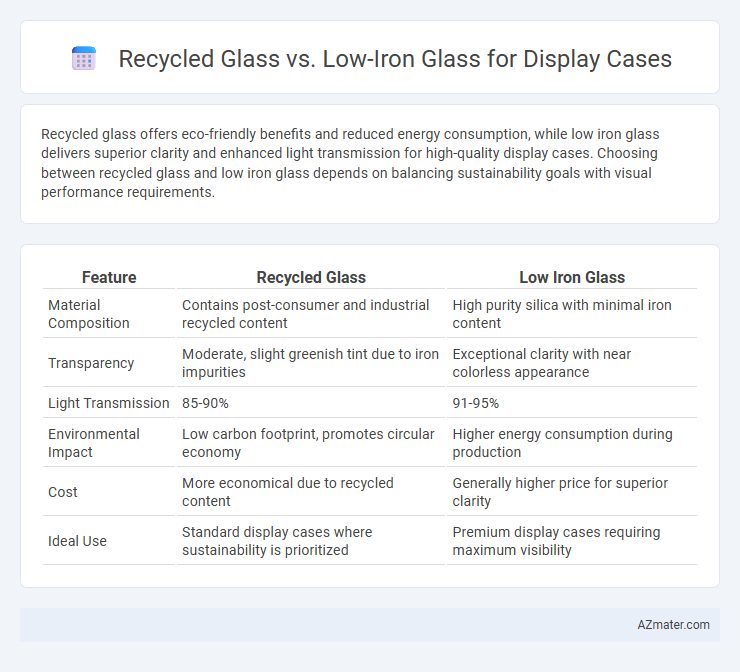Recycled glass offers eco-friendly benefits and reduced energy consumption, while low iron glass delivers superior clarity and enhanced light transmission for high-quality display cases. Choosing between recycled glass and low iron glass depends on balancing sustainability goals with visual performance requirements.
Table of Comparison
| Feature | Recycled Glass | Low Iron Glass |
|---|---|---|
| Material Composition | Contains post-consumer and industrial recycled content | High purity silica with minimal iron content |
| Transparency | Moderate, slight greenish tint due to iron impurities | Exceptional clarity with near colorless appearance |
| Light Transmission | 85-90% | 91-95% |
| Environmental Impact | Low carbon footprint, promotes circular economy | Higher energy consumption during production |
| Cost | More economical due to recycled content | Generally higher price for superior clarity |
| Ideal Use | Standard display cases where sustainability is prioritized | Premium display cases requiring maximum visibility |
Introduction to Display Case Glass Options
Display case glass options vary significantly between recycled glass and low iron glass, each offering distinct benefits for visual clarity and sustainability. Recycled glass provides an eco-friendly choice by incorporating post-consumer materials, reducing environmental impact while maintaining adequate transparency for display purposes. Low iron glass is prized for its superior clarity and reduced green tint, enhancing color accuracy and visibility in high-end retail or museum display cases.
What is Recycled Glass?
Recycled glass is made from post-consumer or post-industrial glass waste that is melted down and reformed into new glass products, significantly reducing energy consumption and raw material use compared to virgin glass production. It often contains impurities and a greenish tint due to iron content, which can affect clarity and color accuracy in display cases. Low iron glass, on the other hand, is specially processed to minimize iron oxide, providing higher transparency and true color representation ideal for premium display cases requiring crystal-clear visibility.
What is Low Iron Glass?
Low iron glass is a high-transparency glass specifically manufactured to minimize iron content, resulting in significantly reduced green tint compared to standard recycled glass. This clarity makes low iron glass ideal for display cases where true color representation and maximum light transmission are crucial for showcasing products. While recycled glass is eco-friendly, its higher iron content can cause a greenish hue that may alter the appearance of displayed items, making low iron glass the preferred choice for pristine visual quality.
Visual Clarity Comparison
Recycled glass often contains impurities and slight greenish or brownish tints, reducing visual clarity in display cases compared to low iron glass. Low iron glass features higher purity and reduced iron content, resulting in exceptional transparency and minimal color distortion, ideal for showcasing products with true-to-life color representation. Choosing low iron glass enhances display aesthetics by providing sharper, clearer views and better light transmission, critical for premium visual presentation.
Strength and Durability Factors
Recycled glass for display cases often has variable strength due to impurities and inconsistent composition, making it less reliable under stress compared to low iron glass, which undergoes precise manufacturing to ensure superior durability and resistance to impact. Low iron glass offers enhanced clarity and structural integrity, reducing the risk of breakage and maintaining its strength over time, ideal for high-traffic or heavy-use display environments. Strength factors heavily favor low iron glass as it combines optimized chemical purity with controlled tempering processes, resulting in longer-lasting, more resilient display cases.
Environmental Impact and Sustainability
Recycled glass in display cases significantly reduces energy consumption and raw material extraction by reusing existing glass, lowering carbon emissions and landfill waste. Low iron glass, while offering superior clarity and aesthetic appeal, typically involves higher energy inputs and raw material use, resulting in a larger environmental footprint. Choosing recycled glass supports circular economy principles and enhances sustainability by minimizing resource depletion and promoting waste reduction in the glass manufacturing process.
Cost Analysis
Recycled glass for display cases offers a cost-effective solution by reducing material expenses and energy consumption during production, often resulting in savings of up to 30% compared to traditional low iron glass. Low iron glass typically incurs higher costs due to its superior clarity and reduced iron content, which require more refined processing techniques and raw materials. Businesses aiming for budget-conscious options without significantly compromising aesthetics frequently prefer recycled glass for its balance of affordability and environmental benefits.
UV Protection and Preservation
Recycled glass and low iron glass differ significantly in UV protection and preservation qualities for display cases; low iron glass offers superior clarity and enhanced UV blocking properties, reducing damage to sensitive items by filtering harmful ultraviolet rays more effectively than recycled glass. Recycled glass contains impurities that can reduce transparency and UV protection, potentially accelerating the fading and deterioration of displayed artifacts. Selecting low iron glass optimizes preservation by minimizing UV exposure, thus maintaining the integrity and appearance of collectibles over time.
Applications in Museums and Retail
Recycled glass offers sustainable benefits and reduced environmental impact for museum and retail display cases, providing adequate clarity and durability for protecting artifacts and products. Low iron glass delivers superior optical clarity with minimal green tint, enhancing visual appeal and true color representation in premium museum exhibitions and high-end retail showcases. Both materials support UV protection and scratch resistance, crucial for preserving items and maintaining display quality in controlled environments.
Choosing the Best Glass for Your Display Case
Choosing between recycled glass and low iron glass for your display case depends on clarity and environmental impact. Low iron glass offers superior transparency and true color representation, making it ideal for showcasing valuables with minimal distortion. Recycled glass provides an eco-friendly option but may have a slight green tint, which can affect visual clarity in high-end displays.

Infographic: Recycled glass vs Low iron glass for Display case
 azmater.com
azmater.com